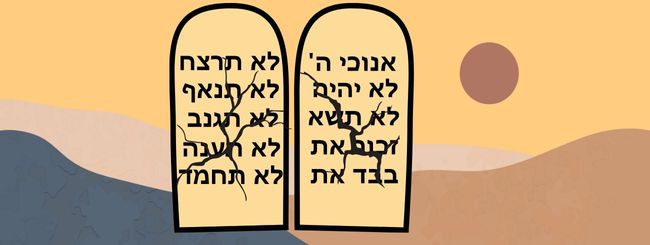בס”ד
Exodus 30:11-34:35
15 And Moses turned, and went down from the mount, with the two tables of the testimony in his hand; tables that were written on both their sides; on the one side and on the other were they written. 16 And the tables were the work of God, and the writing was the writing of God, graven upon the tables. (Exodus 32:15-16)
Reflecting upon verse 16, we can ask why it appears at this point, instead of earlier, when the luchot (the stone tablets with the Ten Commandments) were first given to Moses (ibid., 31:18). Amazingly, this verse appears only four verses before Moses’s shattering of the luchot (ibid., verse 19). If the tablets were “the work of G-d”, how could Moses have broken them?
Placing aside these questions for a moment, let’s look at a fascinating passage from the gemara:
Rav Chisda said: the mem and the samech in the luchot miraculously stood in place.
And Rav Chisda said: the writing on the luchot could be read from the front and the back, like this: נבוב בובן סרו ורס. (Shabbat 104a)
Based on this passage, we know that the phrase, “the writing was the work of G-d” refers to this miracle. The letters final mem (ם) and samech (ס) are both circular, and in order for them to appear, there needs to be a portion of the stone of the tablets remaining in place; if the writing went all the way through the tablet, that portion of stone would have to have hung in midair. Such was the miracle of the luchot.
Tosefot (loc. cit.) ask, since the words נבוב בובן סרו ורס do not actually appear in the luchot, why did Rav Chisda use them as examples of the miracle? The Maharsha answers Tosefot’s question by stating that these examples were given simply to demonstrate that the writing pierced all the way through the luchot, and that if one were to read the writing from the back, he would see the text exactly in reverse. However, no inherent meaning is meant to be derived from the text read backwards, (as one could hear the phrase, “Paul is dead” by playing the Beatles’ ‘Revolution No. 9’ backwards).
At the same time, the Meshech Chochma (Rabbi Meir Simcha of Dvinsk, 1843-1926) suggests that, indeed, there is a meaning to the reverse luchot as well. There are two ways to contemplate, and hence connect to, G-d. One is to cast one’s eyes upwards towards the unfathomable nature of G-d and His Guiding Power. This corresponds to the luchot read from right to left (from the front). The other way is to direct one’s eyes downwards towards the Creation and discover the inherent wisdom in it. This corresponds to the luchot read from left to right.
Regarding the latter, the gemara states, “Rabbi Yochanan said, ‘had the Torah not been given, we would have learned modesty from the cat, hatred of theft from the ant, loyalty from the dove, and manners from birds” (Eruvin 100b). In addition, the sages have stated, “had the Torah’s laws not been written, it would have been fitting to write them, such as those that outlaw theft, forbidden relations, idolatry, blasphemy, and murder” (Torat Kohanim, Acharei Mot 9:13). The fundamental sensitivities that all of humanity should have can be invoked by tuning in to what must happen down here on Earth. And, of course, matters of holiness and eternity can be acquired by gazing upwards.
Both of these levels of understanding are inaccessible to a person who has fallen into the trap of idolatry, the notion that some other force besides G-d Himself exerts control over the guidance of the universe. Ironically, had Moses not broken the tablets, it could have been much worse. Israel had temporarily re-oriented itself towards idolatry, and the tablets were in fact, “the work of G-d”. If Moses had not shattered them, the luchot would have become objects of worship, instead of the G-d Who gave them. We have many items that we place at center stage; we usually refer to them by saying, “the centrality of _____”. But only G-d can and should have center stage. Not one’s honor, nor their money, nor their country and nor their reputation.
The last two verses of the Torah state, “And there has not arisen a prophet since in Israel like Moses, whom the L-RD knew face to face; in all the signs and the wonders, which the L-RD sent him to do in the land of Egypt, to Pharaoh, and to all his servants, and to all his land; and in all the mighty hand, and in all the great awe, which Moses wrought in the sight of all Israel.” (Deuteronomy 34:11-12). What was the “great awe”, Moses’s crowning achievement? Rashi (loc.cit.) states that this refers to the shattering of the luchot!
May we be blessed to perceive G-d’s presence in the world and in our lives, and to partner with Him in bringing His world to perfection.
GOOD SHABBOS! SHABBAT SHALOM!
By Rabbi Tani Burton
© Copyright, all rights reserved. If you enjoyed this article, we encourage you to distribute it further.
Our blogs may contain text/quotes/references/links that include copyright material of Mechon-Mamre.org, Aish.com, Sefaria.org, Chabad.org, and/or AskNoah.org, which we use in accordance with their policies.
